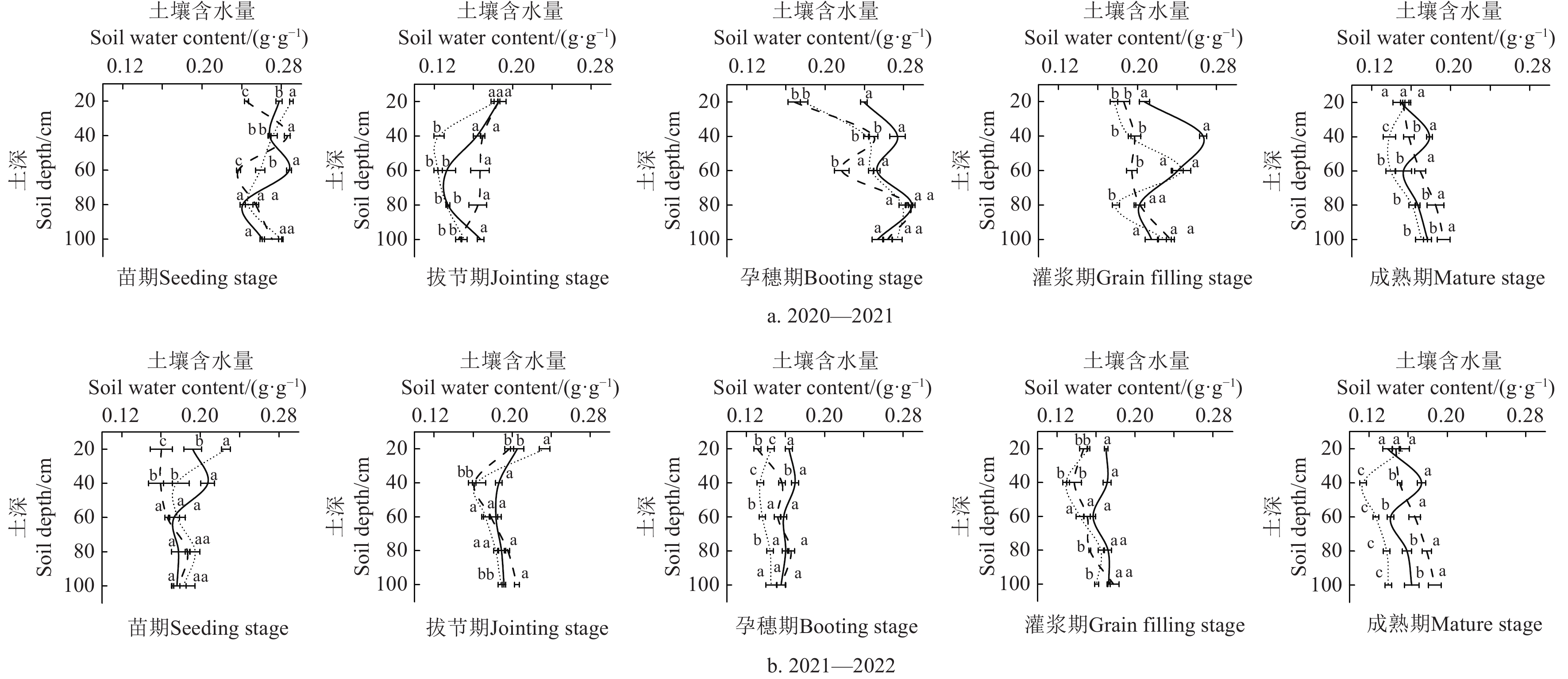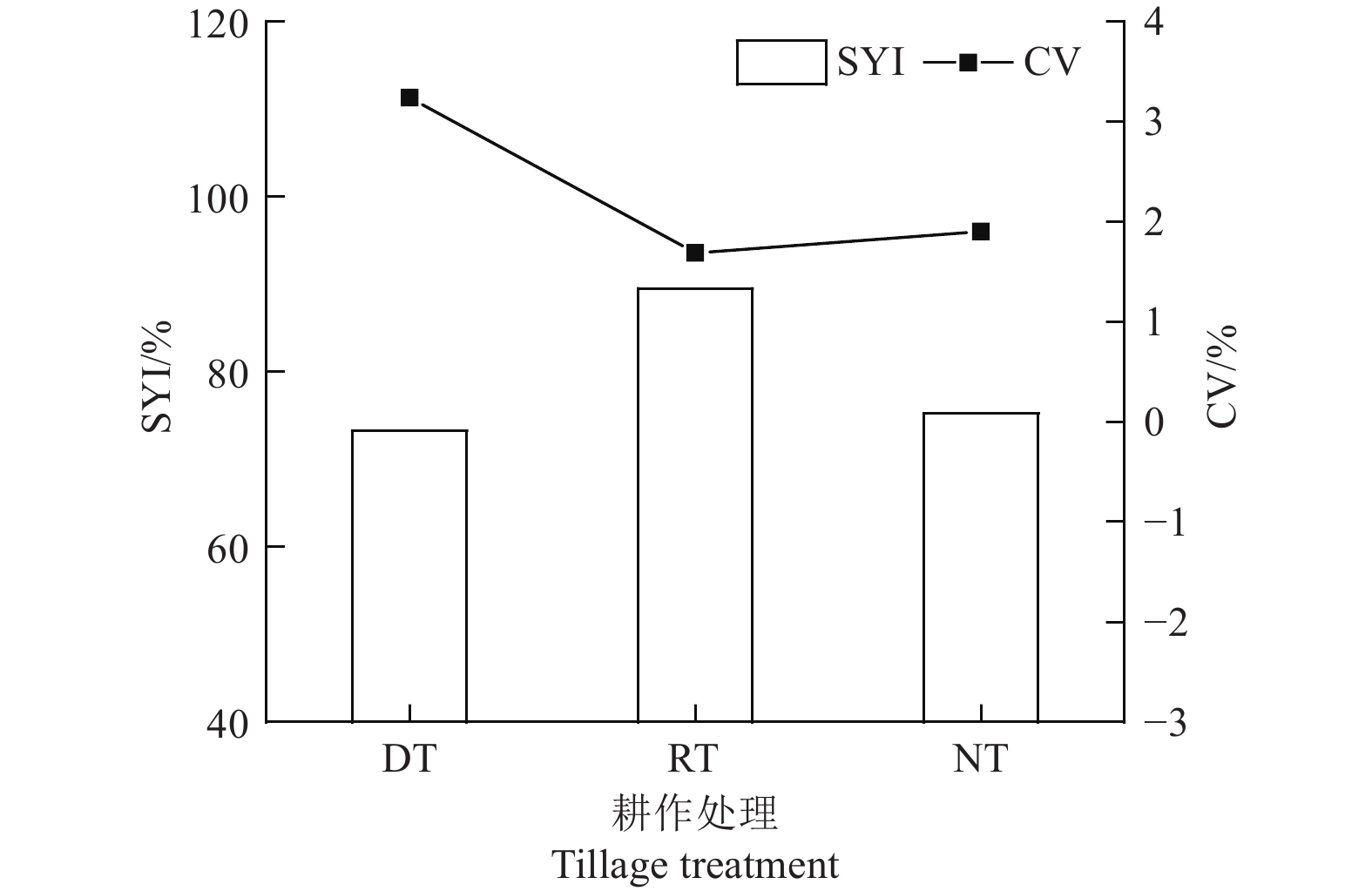Appropriate tillage regime for the improvement of winter wheat yield, soil water, and nutrients condition in Huanghuaihai Plain of China
-
摘要:
为了探索黄淮海小麦生产适宜的耕作模式,该研究设计长期定位试验(2017—2022年)对比了简化耕作模式深耕(deep tillage,DT)、轮耕(rotational tillage,RT)和免耕(no-tillage,NT)对冬小麦产量和土壤水肥状况的影响。结果表明:RT处理显著提高了冬小麦苗期0~20 cm土层土壤水分吸收利用情况,冬小麦孕穗期、灌浆期RT处理0~20、>20~40 cm土层土壤含水量显著高于DT、NT处理。RT处理0~20、>20~40 cm土壤全氮、有机质含量和碳氮比含量较DT、NT处理显著提高, 2021—2022年0~20 cm土壤全氮、有机质含量、碳氮比RT处理较DT和NT处理分别显著提高40.45%和31.58%、56.66%和45.34%、11.62%和9.91%。2020—2021年和2021—2022年RT处理冬小麦产量较DT、NT处理分别显著提高20.20%、13.39%和20.35%、18.74%。RT处理显著增加了冬小麦千粒质量,其产量变异系数最低,产量可持续指数最高,说明RT处理有助于增加冬小麦生产力稳定性和可持续性,可以实现黄淮海冬小麦高产稳产。研究可为黄淮海平原冬小麦生产应用一年深耕、两年免耕的轮耕耕作模式提供理论指导与技术支撑。
Abstract:Appropriate tillage practice can be beneficial to the water and nutrient supplying in wheat production in Huanghuaihai Plain of China. The long-term deep plough can induce the hardpan, leading to the significant influence on the nutrient cycling and crop yield. No-tillage has been proven an effective tillage practice in the nutrient supply with the low yield. A rotational tillage system incorporated no-tillage and deep tillage can greatly contribute to the wheat production in the yield advancement and nutrient cycling. The long-term field experiment was conducted from 2017 to investigate the deep tillage in consecutive years (DT), rotational tillage with three years cycle for one-year deep tillage and two years no tillage (RT), and no-tillage in consecutive years (NT) on winter wheat yield, soil water and nutrient content in wheat growing season of 2020-2021 and 2021-2022. The results showed that the RT treatment significantly improved the soil water consumption in the 0-20 cm soil layer at seeding stage. And the soil water content in 0-20 and below 40 cm soil depth was significantly higher in the RT than in the DT and NT treatment at booting and filling stage. Soil water content of 20-40 cm soil layer in the RT treatment was significantly higher than in the DT and NT for 8.87%, 7.85%, 11.63% and 20.92% in 2020-2021 and 2021-2022 respectively. Soil total nitrogen content, organic matter and C/N ratio was significantly higher in the RT than in DT and NT. In the end of wheat growing season of 2021-2022, soil total nitrogen content of 0-20 cm soil depth was significantly higher in the RT than in the DT and NT for 40.45% and 31.58% respectively, soil organic matter was significantly higher than in the RT than in the DT and NT for 56.66% and 45.34% respectively, and C/N ratio was significantly higher than in RT than in DT and NT for 11.62% and 9.91% respectively, while the soil available potassium content of 0-20 cm soil layer was significantly higher in the NT than in the DT and RT for 17.91%, 19.10%, 24.32% and 34.00% in the end of wheat growing season of 2020-2021 and 2021-2022 respectively. Winter wheat yield of the RT treatment was significantly higher than the DT and NT treatment by 20.20%, 13.39%, 20.35% and 18.74% in 2020-2021 and 2021-2022 respectively. The 1 000-grain weigh was significantly higher in the RT treatment than in the DT and NT treatment. The RT treatment had the lowest yield interannual variability (CV) and the highest yield sustainability index (SYI) among the three tillage treatments. The positive effect yield advancement and soil nutrients content in the RT treatment revealed that rotational tillage with one year no-tillage and two years deep tillage was an appropriate tillage practice for winter wheat production in Huanghuaihai Plain of China, particularly in the yield sustainability and soil nutrient improvement.
-
Keywords:
- nutrients /
- nitrogen /
- fertilizers /
- tillage practice /
- winter wheat /
- yield /
- soil moisture
-
0. 引 言
小麦是中国三大粮食作物之一,其播种面积和产量占全国粮食作物的1/4左右[1]。黄淮海平原是中国重要的小麦生产基地,产量贡献率达57%,降水年内、年际间分布不均,干旱、渍涝灾害频发[2-3]。小麦生产过程中以深翻耕为主要耕作方式,长期翻耕导致土壤结构受损[4],耕层变浅、压实层紧实上移[5],引起土壤蓄水保墒能力下降[6],土壤退化等问题,严重制约该区小麦生产[7-8]。保障小麦可持续生产并减轻土壤退化现状,建立科学合理耕作模式是实现该地区小麦稳产高产的关键所在。为逆转或减轻土壤退化现状,有研究表明可通过改变耕作方式调节土壤水、肥、气、热的关系,解决作物和土壤环境之间矛盾,减少土壤养分和水分流失,促进作物正常生长发育[9]。通过合理配置土壤耕作模式,将深耕、免耕等土壤耕作措施进行合理组合与轮换,既能弥补各项单一土壤耕作措施的不足,又有利于充分和持续均衡土壤水分,达到蓄水保墒、增产增收等效应[10]。
耕作方式对土壤理化性质及作物产量的研究较多,但结果差异较大。相比于常规耕作,深耕能够打破坚硬的犁底层,提高土壤水分渗透强度[11],同时将表层的养分与整个耕层充分混合,从而缓解土壤紧实对有效养分的限制,但对土壤扰动程度大,且产生的积极效应不持久[12]。传统连年旋耕作业可导致耕层过浅、犁底层变硬,土壤养分表层积聚,作物生育后期供肥能力变差 [13]。免耕被认为是改善土壤结构较为优异的耕作措施,可降低机械化翻动对土壤结构的破坏,有效增强土壤蓄水保墒的能力,但连年免耕易使土壤容重增加,影响作物根系的生长发育,而免耕与秸秆还田等措施结合又易在土壤表层滋生病虫害,不利于小麦生产[13]。孙海国等[14]发现随土壤扰动程度降低,土壤养分含量增加,表层有机质含量也增加。目前,国内外采用多种耕作方式交替进行的轮耕模式,在维持作物产量,提高土壤质量方面具有一定优势,有学者对美国中北部免耕持续年限调查发现,平均在1.4 a或2.5 a之后须采取其他耕作方式[15]。王玉玲等[16]研究发现在黄土旱塬区进行免耕-深松组合的逐年轮耕模式能提高冬小麦生育期0~200 cm土壤含水量。候贤清等[17]在宁夏南部半干旱区研究发现深松-免耕、免耕-深松的隔年轮耕模式较传统连年翻耕提高了0~40 cm土壤有机质含量。于淑婷等[18]在黄淮海麦玉两熟区研究发现深耕-旋耕、深耕-旋耕-旋耕模式增加了10~40 cm土层有机碳和氮储量。蒋向等[19]在河南新乡研究发现旋耕2 a后深耕较连续3 a旋耕更能改善麦田土壤物理性状。孔凡磊等[20]在河北栾城研究发现免耕-翻耕、免耕-旋耕的轮耕组合较连年免耕显著提高了冬小麦有效穗数,且分别增产11.8%、16.9%。关小康等[21]在河南商丘研究发现深耕-免耕结合较传统连年深耕可使冬小麦增产8.7%~7.0%。
轮耕模式在耕作组合和频次等方面受种植模式、土壤质地和区域小气候等因素的影响,在半干旱一年一熟种植制度下的黄土高原、东北黑土区耕作方式多为翻耕结合深松和浅旋耕隔年进行,以此实现土壤水分保蓄。而黄淮海平原冬小麦-夏玉米周年复种轮作模式下,连年深耕可导致耕层土壤变浅、犁底层加厚变硬、土壤水分保蓄能力不足、土壤养分循环转化困难,在高强度耕作和作物生产模式下,以土壤水肥持续稳定供应支撑一年两熟小麦玉米生产是该区需要着重考虑的重要问题。
综上,前人多采用多种耕作措施组合,而对简化耕作措施组合的研究较少,因此,本研究以长期定位试验的方式,设置连年深耕、一年深耕两年免耕(轮耕)和连年免耕3种耕作模式,探究冬小麦-夏玉米周年复种轮作耕作措施对土壤水肥状况和小麦产量的影响,优化调整维持和稳定土壤质量,以期为黄淮海平原冬小麦生产探索适宜的耕作模式提供理论依据和技术支持。
1. 材料与方法
1.1 试验地概况
试验在豫西北温县平安种业试验基地(34°56’55” N,112°59’1” E,海拔109 m)进行。该区属暖温带大陆性季风气候,四季分明,光照充足,年平均气温14~15 ℃,年积温4 500 ℃以上,年日照2484 h,降水多集中在7—9月,年降水量550~700 mm,无霜期210 d。供试土壤的质地为中壤土,其耕层(0~40 cm)初始的理化性状如下:有机质含量12.39 g/kg,全氮1.18 g/kg,有效磷20.12 mg/kg,速效钾94.66 mg/kg,土壤砂粒、粉粒、黏粒质量分数分别占18.60%、42.20%和39.20%,土壤容重1.45 g/cm3。2020年10月—2022年6月的气温和降雨量见图1。
1.2 试验设计
长期耕作定位试验始于2017年,本研究于2020年10月—2021年6月,2021年10月—2022年6月冬小麦季开展调查与取样测定,采用冬小麦-夏玉米一年两熟种植模式,设置3种耕作模式,即冬小麦季连年深耕(deep tillage,DT)、连年免耕(no-tillage,NT)、 3 a循环式深耕免耕相结合,即第一年小麦季深耕,第二和第三年小麦季免耕的轮耕模式(rotation tillage,RT)。每个模式设置3次重复,小区面积600 m2(40 m×15 m),各小区间隔1 m。
耕作处理如下:深耕处理均在每年冬小麦播种前进行,耕作深度为30 cm;免耕处理对土壤不耕作;轮耕处理于2020—2021年小麦季播前深耕,2021—2022年小麦季免耕播种;3个处理均为当季作物秸秆粉碎还田。
供试冬小麦品种平安11,小麦播深2~3 cm,播量195 kg/hm2,行距20 cm。播种前对种子进行包衣处理,施复合肥(N-P2O5-K2O=25-14-6)用量均为750 kg/hm2,拔节期追肥(N-P2O5-K2O=30-5-5)600 kg/hm2。灌溉方式为微喷灌,苗期灌水30 mm,拔节期、孕穗期和灌浆期分别灌水60 mm,其他田间管理与当地管理相同。
1.3 测定项目与方法
1.3.1 土壤含水量
于冬小麦苗期(2020年12月26日和2021年12月21日),拔节期(2021年3月25日和2022年3月28日)、孕穗期(2021年4月11日和2022年4月13日)、灌浆期(2021年4月29日和2022年4月30日)和成熟期(2021年6月3日和2022年6月6日),采用土钻法获取0~100 cm土样,每隔20 cm取一个样,用烘干法测定土壤含水量。
1.3.2 土壤养分的测定
冬小麦收获后测定0~20、>20~40 cm土层的土壤养分含量,经自然风干后,碾碎土样,过0.25和1 mm筛子待测[22],采用凯氏定氮法测定全氮含量,钼锑抗比色法测定有效磷含量,火焰光度法测定速效钾含量,重铬酸钾外加热法测定有机质, 土壤pH值采用pH计测定。
1.3.3 冬小麦产量的测定
于冬小麦成熟期,各处理选取10株小麦用于考种,每个处理选取有代表性的1 m2小麦植株,5次重复,带回实验室后测产并计算产量,脱粒后将植株样其他部位放至烘箱85 ℃烘干至恒质量并称量,得到地上部生物量。收获指数为籽粒产量与地上部生物量的比值。收获指数为籽粒产量与地上部生物量的比值。
用变异系数(coefficient of variance,CV)表示产量稳定性,衡量各处理不同年间的变异程度,其值越小,表明产量稳定性越高。CV为产量标准差(σ)与平均产量(Ym)的比值。
产量可持续性指数(sustainable yield index,SYI)是衡量生态系统可持续生产的参数,其值越大,表明可持续性好,按照以式(1)计算。
SSYI=(Ym−σ)/Ymax×100% (1) 式中 Ymax为试验点最高产量,kg/hm2;SSYI为SYI。
1.4 数据处理与分析
采用单因素方差分析耕作模式对冬小麦土壤含水量、土壤养分和产量的影响,使用Microsoft Excel 2016进行数据处理,用SPSS 26.0进行方差分析和相关性分析,应用Origin 2021进行绘图。
2. 结果与分析
2.1 不同耕作方式对土壤含水量的影响
不同耕作处理下冬小麦生育期内0~100 cm土壤含水量变化动态如图2所示。冬小麦土壤含水量变化受耕作方式的影响显著,从不同耕作处理土壤含水量时空分布变化来看,总体上各耕作处理土壤含水量随土层深度呈高-低-高的趋势,同时随生育期推进各土层土壤含水量呈降低趋势:免耕(NT)在苗期较轮耕(RT)、深耕(DT)显著提高了0~20 cm土壤含水量,RT在孕穗、灌浆期较DT、NT显著提高了0~20 、>20~40 cm土壤含水量,DT在成熟期较RT、NT显著提高了>60~100 cm土壤含水量。从年际变化来看,两个试验年度各处理土层土壤含水量变化趋势总体一致:在苗期,NT处理0~20 cm土壤含水量较RT、DT显著提高4.26%和14.99%(2020—2021年)、15.57%和29.11%(2021—2022年);在拔节期,NT处理0~20 cm土层含水量较RT、DT显著提高12.64%和15.54%(2021—2022年))。RT处理在孕穗期0~20 cm土壤含水量较DT和NT处理分别显著提高25.47%和11.14%(2020—2021年)、29.65%和19.75%(2021—2022年),>20~40 cm土壤含水量分别显著提高27.90%和24.62%(2020—2021年)、19.69%和26.04%(2021—2022年)。
![]() 图 2 2020—2022年耕作模式处理下冬小麦生育期土壤含水量注:DT为深耕;RT为轮耕;NT为免耕;不同小写字母表示不同处理间差异显著(P<0.05)。下同。Figure 2. Soil water content during the growth period of winter wheat under different tillage mode treatments in 2020-2022Note : DT is deep tillage; RT is rotational tillage; NT is no-tillage. Different lowercase letters indicate significant differences among different treatments (P<0.05). Same as below.
图 2 2020—2022年耕作模式处理下冬小麦生育期土壤含水量注:DT为深耕;RT为轮耕;NT为免耕;不同小写字母表示不同处理间差异显著(P<0.05)。下同。Figure 2. Soil water content during the growth period of winter wheat under different tillage mode treatments in 2020-2022Note : DT is deep tillage; RT is rotational tillage; NT is no-tillage. Different lowercase letters indicate significant differences among different treatments (P<0.05). Same as below.在灌浆期,RT处理0~20 cm土壤含水量较DT和NT处理分别显著提高10.11%和13.54%(2020—2021年)、10.61%和14.94%(2021—2022年),>20~40 cm土壤含水量分别显著提高8.87%、7.85%(2020—2021年)、11.63%和20.92%(2021—2022年)。在成熟期,DT处理>60~80 cm土壤含水量较RT、NT处理显著提高23.43%和22.81%(2021—2022年), >80~100 cm土壤含水量显著提高24.51%和25.37%(2021—2022年)。
2.2 不同耕作方式对耕层土壤养分的影响
不同耕作处理对冬小麦耕层土壤养分的影响如图3所示。2020—2021年和2021—2022年不同耕作处理0~20 cm土层全氮(TN)、有机质(SOM)、有效磷(AP)和速效钾(AK)含量均高于>20~40 cm土层,且2020—2021年和2021—2022年小麦季各土层AN、SOM、AP和碳氮比(CN)均表现出RT处理显著高于NT和DT处理。
在2020—2021年,较DT处理,RT处理显著提高0~20 cm土层TN、SOM和CN 27.06%、63.79%和28.95%,较DT与NT,RT使 >20~40 cm土层TN、SOM和CN分别提高了26.98%和25.00%、57.16%和25.96%、23.56%和0.89%。在2021—2022年,较DT和NT处理,RT处理显著提高0~20 cm土层TN、SOM和CN 40.45%和31.58%、56.66%和45.34%、11.62%和9.91%,使 >20~40 cm土层TN、SOM和CN分别提高了57.14%和22.22%、91.35%和43.02%、20.92%和16.96%。两个试验年度0~20 cm土层AK含量表现出免耕处理最高,分别显著高于轮耕和深耕处理17.91%和19.10%(2020—2021年)、24.32%和34.00%(2021—2022年)。
2.3 不同耕作方式对冬小麦产量与产量可持续特征的影响
不同耕作处理对冬小麦产量和千粒质量影响显著(表1),较DT和NT处理相比,RT处理产量提高了20.20%和13.39%(2020—2021年)、20.35%和18.74%(2021—2022年)。分析产量构成因素发现,两个试验年度RT处理较NT处理显著提高了千粒质量,与NT处理相比,RT处理千粒质量显著提高9.97%(2020—2021年)、8.44%(2021—2022年)。两个试验年度收获指数均表现为轮耕>免耕>深耕。由此可知,轮耕处理高产主要通过提高千粒质量来实现,其产量构成穗数、穗粒数较协调,同时也促进收获指数协同提高。
表 1 不同耕作方式对小麦产量及其构成因素的影响Table 1. Effect of different tillage methods on wheat yield and its components年度
Year处理
Treatment穗数
Spike number穗粒数
Grain number per spike千粒质量
1000-grain mass/g产量
Yield/(kg·hm−2)收获指数
Harvest index2020—2021 DT 647.25±56.73a 36.11±2.58a 51.23±1.05ab 8 160.42±357.95b 0.42 RT 662.25±66.22a 37.67±1.08a 54.16±1.78a 9 808.56±259.00a 0.43 NT 714.75±25.54a 36.67±2.17a 49.25±1.02b 8 650.32±164.96b 0.42 2021—2022 DT 628.00±41.92b 35.90±0.40a 46.99±0.90b 8 444.48±273.37b 0.42 RT 654.50±35.01ab 39.87±1.31a 53.09±2.74a 10 163.03±171.46a 0.45 NT 694.00±21.7a 39.00±2.72a 48.96±1.89b 8 559.00±162.58b 0.43 不同耕作处理对产量(CV)和(SYI)的影响存在差异(图4),CV大小顺序为深耕>免耕>轮耕,CV越大,产量越不稳定。SYI大小顺序为轮耕>免耕>深耕,SYI值越大,说明产量可持续性越好。由此可知,轮耕处理的变异系数低,产量可持续指数较高,说明冬小麦产量稳定性、可持续性越好,是促进冬小麦生产力可持续性有效耕作模式。
2.4 小麦产量与土壤水分、养分的相关性分析
对冬小麦产量和土壤水分养分进行相关分析结果见表2。
表 2 产量与土壤养分和土壤含水量的相关性分析Table 2. Correlation analysis of yield with soil nutrients and soil water content土层Soil layer/cm 指标Index 相关系数Correlation coefficient 0~20 TN 0.96** SOM 0.99** CN 0.82* pH 0.047 AP 0.46 AK −0.22 WT 0.95** >20~40 TN 0.90* SOM 0.94** CN 0.83* pH 0.058 AP 0.91* AK 0.62* WT 0.92** >40~60 WT 0.22 >60~80 WT −0.80 >80~100 WT −0.65 注:TN、SOM、CN、AP、AK和WT分别为为土壤全氮、有机质、碳氮比、有效磷、速效钾含量和土壤含水量。*,P<0.05;**,P<0.01。 Note: TN, SOM, CN, AP, AK and WT are soil total nitrogen, organic matter, carbon-nitrogen ratio, available phosphorus, available potassium content and soil water content, respectively. *,P<0.05;**,P<0.01. 表2表明,产量随0~20、>20~40 cm土层的全氮(TN)、有机质(SOM)、碳氮比(CN)和土壤水分(WT)的增加而增加,且均呈现出显著正相关关系(P<0.05),与0~20 cm土壤pH、有效磷(AP)、速效钾(AK)和>40~100 cm WT无显著相关关系。其中,小麦产量(Y)与0~20 cm TN、0~40 cm SOM和WT呈极显著相关关系(P<0.01)。
3. 讨 论
3.1 土壤含水量对不同耕作方式的响应
土壤水分是土壤重要的组成部分,是作物吸水的重要来源[23]。土壤水分含量可以反映土壤供应水分能力的高低,对作物生长发育和产量有较大影响。试验结果表明,在苗期NT处理显著提高0~20 cm土壤水分含量,少免耕加秸秆覆盖降低水分散失,极大提高土壤蓄水保墒能力[24]。冬小麦苗期底墒充足确保一播全苗,此期麦苗素质关系后期产量的高低[25]。RT处理显著提高了冬小麦苗期0~20 cm土层土壤水分吸收利用,促进冬小麦对土壤养分的吸收。各耕作处理均能提高0~40 cm土层土壤含水量,其中影响较大的是RT和NT处理,这可能由于免耕通常以前茬作物秸秆形成的天然覆盖层,使太阳辐射降低,从而减少土壤水分蒸散、土层扰动和地表径流[24]。RT处理两年免耕后进行深耕作业,破除板结、打破犁底层,增强土壤接纳灌溉水和自然降雨的能力,进而能有效促进降水入渗,增加蓄水能力[26],RT处理将深耕、免耕的优势进行组合,产生积极效应,以最大程度上保存土壤水分,提高土壤水分稳定供应能力,这为作物增产提供保障[27],这与杨佳宇等[28]在黑土农田进行深翻-旋耕的轮耕组合提高30~45 cm土壤含水量研究结果一致。在孕穗期、灌浆期RT处理0~20、>20~40 cm土壤含水量最高,这是由于耕作方式可以改变土壤物理性质,影响土壤水分运移[29],有利于小麦活跃根系对土壤水分的吸收利用。试验发现三种耕作处理在>40~100 cm土层内随土层深度增加土壤含水量呈升高趋势,>40~100 cm以下土壤含水量更均匀、水分差距缩小,有利于水分在深层土壤的积蓄,且RT处理能有效保蓄降水,对水分供应能力强[30]。
3.2 土壤养分对不同耕作方式的响应
试验表明各耕作处理>20~40 cm相较于0~20 cm土层养分含量呈下降趋势,这是由于不同耕作方式对土层扰动程度的大小不同,进而影响养分在土壤中的分布情况,这与薛兰兰[31]研究土壤养分含量随土层加深均出现降低趋势的研究结果一致。一般认为,长期连续采取单一耕作措施会逐渐降低土壤耕层养分含量,试验结果表明,连年DT、NT使0~20 cm土层全氮、有效磷含量呈下降趋势,有学者研究发现长期定位单一免耕耕作会降低5~10 cm亚表层全氮含量[32]。0~20、>20~40 cm土壤全氮、有效磷、有机质和碳氮比的变化规律一致,具体表现为RT > NT >DT,这由于RT打破养分在土壤剖面常年单一的空间分布,增加土壤透气性,促使土壤矿化增强,养分得以释放,避免养分富集在表层土壤,提高土壤结构质量[33]。张琦等[34]研究发现免耕-翻耕-深松轮耕模式下0~40 cm土层有机质和全氮含量增加。赵刚等[35]在豫西地区采取免耕方式显著提高了0~20 cm土壤有机碳含量,王改玲等[36]研究表明长期免耕能增加土壤有机质含量,因为免耕对下层土壤几乎没有扰动,空气对深层土壤的接触减少。试验发现RT、NT处理土壤有效钾含量随耕作年限越久呈上升趋势,这是由于秸秆与耕层土壤混合腐解,释放磷、钾等营养元素[37],这与朱长伟等[38]的深耕-条旋耕-旋耕的轮耕模式有利于提高速效钾含量研究结果一致。通过对小麦产量与土壤养分及土壤含水量的相关性分析发现,不同耕作模式下土壤全氮、有机质、碳氮比对小麦产量的相关性系数高且呈显著正相关,说明不同耕作方式形成了一个相对平衡和较高水平的土壤状况,有利于提高土壤各种养分在植物体内吸收利用,从而提高小麦籽粒产量。
3.3 小麦产量对不同耕作方式的响应
长期采取少、免耕方式,会造成耕层变浅、作物减产的问题[39],张鑫琪等[40]研究发现免耕-旋耕的轮耕模式对旱地小麦产量的影响主要受有效穗数和穗粒数的增加。耕作方式对小麦产量的影响因区域的生态条件、秸秆还田的种类和耕作处理的时长等不同而得到的结论不一致[41]。本文结果表明,RT处理冬小麦产量最高。这主要由于 RT在免耕的农田上进行深耕能够打破机械压迫形成的紧实土壤,通过调节土壤水肥特性、促进根系和地上部发育等生态优势,促进冬小麦增产[42]。RT处理2a免耕后进行土壤深耕,使土壤维持较高水分供应能力和肥力水平,产生残效叠加效应,从而实现作物高产。此外,RT处理在免耕秸秆覆盖2a的基础上进行深耕,具备秸秆覆盖减少蒸发经后茬耕作使秸秆腐解,促进有机碳的周转,发挥增产优势[43]。试验结果表明,轮耕处理小麦产量2个试验年度呈增长趋势,可能原因在于随着定位试验年数的增加,其效应对小麦产量及构成因素具备一定的累积激发效应,同时受2021年夏季特大降雨的影响,深耕充分接纳自然降雨,使冬小麦季土壤底墒充足,同时灌浆期深层水分含量较足,显著提高了小麦千粒质量,这与牛润芝等[44]的深耕-条旋耕的轮耕模式较单一连续旋耕提高千粒质量,增产14.64%研究结果一致。作物高产稳产和可持续生产是农业发展的目标,产量稳定性表现是多个性状稳定性影响的结果,本试验结果表明,RT处理CV值小于NT、DT处理,SYI值大于NT、DT处理,说明RT处理能够减少冬小麦产量的年际间波动,提高小麦产量稳定性、可持续性。
4. 结 论
本研究通过长期定位试验,设置连年深耕、一年深耕两年免耕(轮耕)和连年免耕3种耕作方式,探究冬小麦-夏玉米周年复种轮作耕作措施对土壤水肥状况和小麦产量的影响,结果表明:
1)3种耕作处理土壤含水量随土层深度呈高-低-高的趋势,且年际间变化趋势一致,较深耕、免耕相比,轮耕显著提高冬小麦孕穗期和灌浆期0~20、>20~40 cm土壤含水量。不同耕作处理0~20 cm土层全氮、有机质、有效磷和有效钾含量均高于>20~40 cm土层,2a小麦季0~20、>20~40 cm全氮、有机质、有效磷和碳氮比均表现出轮耕显著高于免耕和深耕。
2)轮耕产量比深耕和免耕高13.39%~20.35%,轮耕高产主要通过提高千粒质量来实现。轮耕产量变异系数低,产量可持续指数高。
3)相关性分析表明,0~20 cm土壤全氮、有机质和含水量,0~20、>20~40 cm土壤有机质和土壤含水量与产量呈极显著相关,对产量影响大。
综上,轮耕能有效提高耕层土壤含水量,有利于增强冬小麦对土壤养分的吸收利用,可有效避免单一耕作带来的弊端,进而提高冬小麦产量稳定性及可持续生产能力,是促进冬小麦生产力可持续的有效耕作模式。
-
图 2 2020—2022年耕作模式处理下冬小麦生育期土壤含水量
注:DT为深耕;RT为轮耕;NT为免耕;不同小写字母表示不同处理间差异显著(P<0.05)。下同。
Figure 2. Soil water content during the growth period of winter wheat under different tillage mode treatments in 2020-2022
Note : DT is deep tillage; RT is rotational tillage; NT is no-tillage. Different lowercase letters indicate significant differences among different treatments (P<0.05). Same as below.
表 1 不同耕作方式对小麦产量及其构成因素的影响
Table 1 Effect of different tillage methods on wheat yield and its components
年度
Year处理
Treatment穗数
Spike number穗粒数
Grain number per spike千粒质量
1000-grain mass/g产量
Yield/(kg·hm−2)收获指数
Harvest index2020—2021 DT 647.25±56.73a 36.11±2.58a 51.23±1.05ab 8 160.42±357.95b 0.42 RT 662.25±66.22a 37.67±1.08a 54.16±1.78a 9 808.56±259.00a 0.43 NT 714.75±25.54a 36.67±2.17a 49.25±1.02b 8 650.32±164.96b 0.42 2021—2022 DT 628.00±41.92b 35.90±0.40a 46.99±0.90b 8 444.48±273.37b 0.42 RT 654.50±35.01ab 39.87±1.31a 53.09±2.74a 10 163.03±171.46a 0.45 NT 694.00±21.7a 39.00±2.72a 48.96±1.89b 8 559.00±162.58b 0.43 表 2 产量与土壤养分和土壤含水量的相关性分析
Table 2 Correlation analysis of yield with soil nutrients and soil water content
土层Soil layer/cm 指标Index 相关系数Correlation coefficient 0~20 TN 0.96** SOM 0.99** CN 0.82* pH 0.047 AP 0.46 AK −0.22 WT 0.95** >20~40 TN 0.90* SOM 0.94** CN 0.83* pH 0.058 AP 0.91* AK 0.62* WT 0.92** >40~60 WT 0.22 >60~80 WT −0.80 >80~100 WT −0.65 注:TN、SOM、CN、AP、AK和WT分别为为土壤全氮、有机质、碳氮比、有效磷、速效钾含量和土壤含水量。*,P<0.05;**,P<0.01。 Note: TN, SOM, CN, AP, AK and WT are soil total nitrogen, organic matter, carbon-nitrogen ratio, available phosphorus, available potassium content and soil water content, respectively. *,P<0.05;**,P<0.01. -
[1] 卢秉林,包兴国,车宗贤,等. 长期留茬免耕对河西绿洲灌区春小麦产量及稳定性的影响[J]. 农业工程学报,2022,38(7):117-126. LU Binglin, BAO Xingguo, CHE Zongxian, et al. Effects of long-term no-tillage with crop stubbles on yield and stability of spring wheat in Hexi Oasis Irrigated Areas[J]. Transactions of the Chinese Society of Agricultural Engineering (Transactions of the CSAE), 2022, 38(7): 117-126. (in Chinese with English abstract)
[2] 缪丽娟,刘冉,邹扬锋,等. 黄淮海平原气候变化及对粮食产量影响研究综述[J]. 河南农业大学学报,2023,57(1):10-20. MIAO Lijuan, LIU Ran, ZOU Yangfeng, et al. A review of climate change in Huanghuaihai Plain and its impact on grain yield[J]. Journal of Henan Agricultural University, 2023, 57(1): 10-20. (in Chinese with English abstract)
[3] 唐晓培,宋妮,陈智芳,等. 黄淮海地区冬小麦种植北界时空演变及未来趋势分析[J]. 农业工程学报,2019,35(9):129-137. Tang Xiaopei, Song Ni, Chen Zhifang, et al. Spatial-temporal distribution and change trend of northern limit of winter wheat planting in Huang-Huai-Hai Plain[J]. Transactions of the Chinese Society of Agricultural Engineering (Transactions of the CSAE), 2019, 35(9): 129-137. (in Chinese with English abstract)
[4] FAN J L, MCCONKEY B G, LUCE M S, et al. Rotational benefit of pulse crop with no-till increase over time in a semiarid climate[J]. European Journal of Agronomy, 2020, 121(1): 1-11.
[5] 刘湘君,乔冠宇,郭丰浩,等. 基于最小数据集的黄淮海旱作区耕层土壤质量评价及障碍分析[J]. 农业工程学报,2023,39(12):104-113. LIU Xiangjun, QIAO Guanyu, GUO Fenghao, et al. Evaluation and obstacle analysis of cultivated horizon soil quality based on MDS in the dry farming areas of Huang-Huai-Hai Region[J]. Transactions of the Chinese Society of Agricultural Engineering (Transactions of the CSAE), 2023, 39(12): 104-113. (in Chinese with English abstract)
[6] 王玉珑,于爱忠,吕汉强,等. 绿洲灌区小麦秸秆还田与耕作措施对玉米产量的影响[J]. 作物学报,2022,48(10):2671-2679. WANG Yulong, YU Aizhong, LYU Hanqiang, et al. Effects of wheat straw returning and tillage practices on corn yield in oasis irrigation area[J]. Acta Agronomica Sinica, 2022, 48(10): 2671-2679. (in Chinese with English abstract)
[7] 卢秉林,车宗贤,包兴国,等. 留茬免耕播种对河西绿洲灌区春小麦出苗和产量的影响[J]. 应用生态学报,2021,32(9):3249-3256. LU Binglin, CHE Zongxian, BAO Xingguo, et al. Effects of no-tillage sowing with crop stubbles on seeding emergence and yield of spring wheat in Hexi Oasis Irrigated Area, Northwest China[J]. Chinese Journal of Applied Ecology, 2021, 32(9): 3249-3256. (in Chinese with English abstract)
[8] 王群,王建,张学林,等. 不同耕作模式下小麦玉米周年生产及土壤养分变化特征[J]. 河南农业大学学报,2015,49(4):429-437. WANG Qun, WANG Jian, ZHANG Xuelin, et al. Change characteristics of wheat and maize anniversary production and soil nutrient content under different rotation tillage patterns[J]. Journal of Henan Agricultural University, 2015, 49(4): 429-437. (in Chinese with English abstract)
[9] 闫雷,喇乐鹏,董天浩,等. 耕作方式对东北黑土坡耕地土壤物理性状及根系垂直分布的影响[J]. 农业工程学报,2021,37(1):125-132. YAN Lei, LA Yuepeng, DONG Tianhao, et al. Soil physical properties and vertical distribution of root systems affected by tillage methods in black soil slope farmlands in Northeast China[J]. Transactions of the Chinese Society of Agricultural Engineering (Transactions of the CSAE), 2021, 37(1): 125-132. (in Chinese with English abstract)
[10] 谢迎新,靳海洋,孟庆阳,等. 深耕改善砂姜黑土理化性状提高小麦产量[J]. 农业工程学报,2015,31(10):167-173. XIE Yingxin, JIN Haiyang, MENG Qingyang, et al. Deep tillage improving physical and chemical properties of soil and increasing grain yield of winter wheat in lime concretion black soil farmland[J]. Transactions of the Chinese Society of Agricultural Engineering (Transactions of the CSAE), 2015, 31(10): 167-173. (in Chinese with English abstract)
[11] 李福建,徐东忆,吴鹏,等. 机械耕作和播种方式对稻茬小麦光合生产和产量的影响[J]. 农业工程学报,2021,37(5):41-49. LI Fujian, XU Dongyi, WU Peng, et al. Effects of mechanical tillage and sowing methods on photosynthetic production and yield of wheat in rice stubble[J]. Transactions of the Chinese Society of Agricultural Engineering (Transactions of the CSAE), 2021, 37(5): 41-49. (in Chinese with English abstract)
[12] GIZACHEW T G, THOMAS K, LARS J M, et al. Short-term effects of loosening and incorporation of straw slurry into the upper subsoil on soil physical properties and crop yield[J]. Soil and Tillage Research, 2018, 184: 62-67.
[13] 郭星宇,王浩,于琦,等. 耕作对渭北旱塬小麦-玉米轮作田土壤水分和产量的影响[J]. 中国农业科学,2021,54(14):2977-2990. GUO Xingyu, WANG Hao, YU Qi, et al. Effects of tillage on soil moisture and yield of wheat-maize rotation field in weibei upland plateau[J]. Scientia Agricultura Sinica, 2021, 54(14): 2977-2990. (in Chinese with English abstract)
[14] 孙海国,LARNEY F J. 保护性耕作和植物残体对土壤养分状况的影响[J]. 生态农业研究,1997(1):49-53. SUN Haiguo, LARNEY F J. Effects of conservation tillage and crop residues on soil nutrient contents[J]. Chinese Journal of Eco-Agriculture, 1997(1): 49-53. (in Chinese with English abstract)
[15] HILL P R. Use of continuous no-till and rotational tillage systems in the central and northern corn belt[J]. Journal of Soil and Water Conservation, 2001, 56(4): 286-290.
[16] 王玉玲,李军. 黄土旱塬区平衡施肥下不同土壤耕作模式的蓄水纳墒及作物增产增收效应研究[J]. 植物营养与肥料学报,2016,22(1):151-163. WANG Yuling, LI Jun. Study on soil water storage, crop yields and incomes under different soil tillage patterns with balance fertilization in the Loess Dryland region[J]. Journal of Plant Nutrition and Fertilizers, 2016, 22(1): 151-163. (in Chinese with English abstract)
[17] 侯贤清,李荣,韩清芳,等. 轮耕对宁南旱区土壤理化性状和旱地小麦产量的影响[J]. 土壤学报,2012,49(3):592-600. HOU Xianqing, LI Rong, HAN Qingfang, et al. Effects of alterate tillage on soil physicochemical properties and yileld of dryland wheat in arid areas of south Ningxia[J]. Acta Pedologica Sinica, 2012, 49(3): 592-600. (in Chinese with English abstract)
[18] 于淑婷,赵亚丽,王育红,等. 轮耕模式对黄淮海冬小麦—夏玉米两熟区农田土壤改良效应[J]. 中国农业科学,2017,50(11):2150-2165. YU Shuting, ZHAO Yali, WANG Yuhong, et al. Improvement effects of rotational tillage patterns on soil in the winter wheat-summer maize double cropping area of Huang-Huai-Hai region[J]. Scientia Agricultura Sinica, 2017, 50(11): 2150-2165. (in Chinese with English abstract)
[19] 蒋向,贺德先,任洪志,等. 轮耕对麦田土壤容重和小麦根系发育的影响[J]. 麦类作物学报,2012,32(4):711-715. JIANG Xiang, HE Dexian, REN Hongzhi, et al. Effect of different patterns of rotational tillage on soil bulk density in wheat field and wheat root deveiopment[J]. Journal of Triticeae Crops, 2012, 32(4): 711-715. (in Chinese with English abstract)
[20] 孔凡磊,陈阜,张海林,等. 轮耕对土壤物理性状和冬小麦产量的影响[J]. 农业工程学报,2010,26(8):150-155. KONG Fanlei, CHEN Fu, ZHANG Hailin, et al. Effects of rotational tillage on soil physical properties and winter wheat yield[J]. Transactions of the Chinese Society of Agricultural Engineering (Transactions of the CSAE), 2010, 26(8): 150-155. (in Chinese with English abstract)
[21] 关小康,王静丽,刘影,等. 轮耕秸秆还田促进冬小麦干物质积累提高水氮利用效率[J]. 水土保持学报,2018,32(3):280-288. GUAN Xiaokang, WANG Jingli, LIU Ying, et al. Rotational tillage with straw returning increased dry matter accumulation and utilization efficiency of water and nitrogen in winter wheat[J]. Journal of Soil and Water Conservation, 2018, 32(3): 280-288. (in Chinese with English abstract)
[22] 鲍士旦. 土壤农化分析. 3版[M]. 北京 中国农业出版社,2000. [23] 王秋菊,刘峰,焦峰,等. 深耕对黑土水分特征及动态变化影响[J]. 土壤通报,2018,49(4):942-948. WANG Qiuju, LIU Feng, JIAO Feng, et al. Effect of deep tillage on water characteristics in black soil[J]. Chinese Journal of Soil Science, 2018, 49(4): 942-948. (in Chinese with English abstract)
[24] 李明,李朝苏,刘淼,等. 耕作播种方式对稻茬小麦根系发育、土壤水分和硝态氮含量的影响[J]. 应用生态学报,2020,31(5):1425-1434. LI Ming, LI Chaosu, LIU Miao, et al. Effects of different tillage and sowing practices on root growth, soil moisture, and soil nitrate nitrogen content of wheat after rice[J]. Chinese Journal of Applied Ecology, 2020, 31(5): 1425-1434. (in Chinese with English abstract)
[25] 韩娟,廖允成,贾志宽,等. 半湿润偏旱区沟垄覆盖种植对冬小麦产量及水分利用效率的影响[J]. 作物学报,2014,40(1):101-109. HAN Juan, LIAO Yuncheng, JIA Zhikuan, et al. Effects of ridging with mulching on yield and water use efficiency in winter wheat in semi-humid drought-prone region in china[J]. Acta Agronomica Sinica, 2014, 40(1): 101-109. (in Chinese with English abstract)
[26] 梁磊,孙浩田,徐高明,等. 田间原位试验分析长期机械作业下稻麦轮作地块土壤入渗性能[J]. 农业工程学报,2023,39(7):110-118. LIANG Lei, SUN Haotian, XU Gaoming, et al. Soil infiltration of rice-wheat rotation field under long-term mechanical treatment based on field in situ experiments[J]. Transactions of the Chinese Society of Agricultural Engineering (Transactions of the CSAE), 2023, 39(7): 110-118. (in Chinese with English abstract)
[27] 王玉凤,陈天宇,付健,等. 不同耕作方式对松嫩平原半干旱区玉米生长和产量的影响[J]. 玉米科学,2022,30(2):104-111. WANG Yufeng, CHEN Tianyu, FU Jian, et al. Effects of tillage methods on maize growth and yield in semiarid area of songnen plain[J]. Journal of Maize Sciences, 2022, 30(2): 104-111. (in Chinese with English abstract)
[28] 杨佳宇,谷思玉,李宇航,等. 深翻-旋耕轮耕与有机肥配施对黑土农田土壤物理性质的影响[J]. 土壤通报,2021,52(6):1290-1298. YANG Jiayu, GU Siyu, LI Yuhang, et al. Effects of deep ploughing-rotary tillage combined with organic fertilizer on black soil physical propertie[J]. Chinese Journal of Soil Science, 2021, 52(6): 1290-1298. (in Chinese with English abstract)
[29] 李玉梅,王根林,孟祥海,等. 不同耕作方式对土壤水分和养分变化的影响[J]. 东北农业大学学报,2018,49(9):54-60. LI Yumei, WANG Genlin, MENG Xianghai, et al. Effect of different soil tillages on soil moisture and nutrient change[J]. Journal of Northeast Agricultural University, 2018, 49(9): 54-60. (in Chinese with English abstract)
[30] 王倩. 保护性轮耕对渭北旱作麦田土壤水肥、作物生长和产量的影响[D]. 杨凌:西北农林科技大学,2018. WANG Qian. Effect of Rotational Conservation Tillage on Soil Water and Fertility, Crop Growth and Yield of Dryland Wheat Field in Weibei Highland[D]. Yangling: Northwest A&F University, 2018. (in Chinese with English abstract)
[31] 薛兰兰. 秸秆覆盖保护性种植的土壤养分效应和作物生理生化响应机制研究[D]. 重庆:西南大学,2011. XU Lanlan. The Effect of Straw Mulch Conservative Cultivation on Soil Nutrients Dynamics and Crop Physio-biochemical Mechanisms[D]. Chongqing: Southwestern University, 2011. (in Chinese with English abstract)
[32] 张向前,杨文飞,徐云姬. 中国主要耕作方式对旱地土壤结构及养分和微生态环境影响的研究综述[J]. 生态环境学报,2019,28(12):2464-2472. ZHANG Xiangqian, YANG Wenfei, XU Yunji. Effects of main tillage methods on soil structure, nutrients and micro-ecological environment of upland in china: A review[J]. Ecology and Environmental Sciences, 2019, 28(12): 2464-2472. (in Chinese with English abstract)
[33] 郭书亚,尚赏,汤其宁,等. 不同轮耕方式与生物炭对土壤酶活性、土壤养分及小麦和玉米产量的影响[J]. 作物杂志,2022(3):211-217. GUO Shuya, SHANG Shang, TANG Qining, et al. Effects of different rotation tillage methods and biochar on soil enzyme activity, soil nutrients and yield of wheat and maize[J]. Crops, 2022(3): 211-217. (in Chinese with English abstract)
[34] 张琦,王浩,王淑兰,等. 深松轮耕模式对黄土旱塬春玉米土壤理化性质和作物产量的影响[J]. 应用生态学报,2020,31(2):459-466. ZHANG Qi, WANG Hao, WANG Shulan, et al. Effects of tillage alternation pattern with subsoiling on soil physical and chemical properties and spring maize yield in the Loess Plateau, China.[J]. Chinese Journal of Applied Ecology, 2020, 31(2): 459-466. (in Chinese with English abstract)
[35] 赵刚,吴会军,张永清,等. 豫西长期不同耕作下土壤肥力质量评价[J]. 中国土壤与肥料,2023(6):1-11. ZHAO Gang, WU Huijun, ZHANG Yongqing, et al. Evaluation of soil fertility quality under long-term different tillage in western Henan[J]. Soil and Fertilizer Sciences in China, 2023(6): 1-11. (in Chinese with English abstract)
[36] 王改玲,郝明德,许继光,等. 保护性耕作对黄土高原南部地区小麦产量及土壤理化性质的影响[J]. 植物营养与肥料学报,2011,17(3):539-544. WANG Gailing, HAO Mingde, XU Jiguang, et al. Effects of conservation tillage on wheat yield and soil physicochemical properties in the southern Loess Plateau[J]. Journal of Plant Nutrition and Fertilizers, 2011, 17(3): 539-544. (in Chinese with English abstract)
[37] 王昌全,魏成明,李廷强,等. 不同免耕方式对作物产量和土壤理化性状的影响[J]. 四川农业大学学报,2001(2):152-154. WANG Changquan, WEI Chengming, LI Tingqiang, et al. Effect of different zero tillage on the crop yield and soil property[J]. Journal of Sichuan Agricultural University, 2001(2): 152-154. (in Chinese with English abstract)
[38] 朱长伟,孟威威,石柯,等. 不同轮耕模式下小麦各生育时期土壤养分及酶活性变化特征[J]. 中国农业科学,2022,55(21):4237-4251. ZHU Changwei, MENG Weiwei, SHI Ke, et al. The characteristics of soil nutrients and soil enzyme activities during wheat growth stage under different tillage patterns[J]. Scientia Agricultura Sinica, 2022, 55(21): 4237-4251. (in Chinese with English abstract)
[39] 张玉娇,王浩,王淑兰,等. 小麦/玉米轮作旱地长期轮耕的保墒增产效应[J]. 农业工程学报,2018,34(12):126-136. ZHANG Yujiao, WANG Hao, WANG Shulan, et al. Soil moisture preservation and improving of crop yield in dry land under long-term wheat/maize rotation[J]. Transactions of the Chinese Society of Agricultural Engineering (Transactions of the CSAE), 2018, 34(12): 126-136. (in Chinese with English abstract)
[40] 张鑫琪,王迎宾,郝兴宇,等. 不同耕作方式对旱地小麦生长发育、生理代谢及产量的影响[J]. 激光生物学报,2022,31(3):278-288. ZHANG Xinqi, WANG Yingbin, HAO Xingyu, et al. Effects of different tillage methods on growth, physiological metabolism, and yield of wheat in dryland[J]. Acta Laser Biology Sinica, 2022, 31(3): 278-288. (in Chinese with English abstract)
[41] 周正萍,田宝庚,陈婉华,等. 不同耕作方式与秸秆还田对土壤养分及小麦产量和品质的影响[J]. 作物杂志,2021(3):78-83. ZHOU Zhengping, TIAN Baogeng, CHEN Wanhua, et al. Effects of different tillage methods and straw returning on soil nutrients and wheat yield and qualit[J]. Crops, 2021(3): 78-83. (in Chinese with English abstract)
[42] 黄明,吴金芝,李友军,等. 耕作方式和氮肥用量对旱地小麦产量、蛋白质含量和土壤硝态氮残留的影响[J]. 中国农业科学,2021,54(24):5206-5219. HUANG Ming, WU Jinzhi, LI Youjun, et al. Effects of tillage practices and nitrogen fertilizer application rates on grain yield, protein content in winter wheat and soil nitrate residue in dryland[J]. Scientia Agricultura Sinica, 2021, 54(24): 5206-5219. (in Chinese with English abstract)
[43] 黄明,吴金芝,李友军,等. 耕作方式和秸秆覆盖对旱地麦豆轮作下小麦籽粒产量、蛋白质含量和土壤硝态氮残留的影响[J]. 草业学报,2018,27(9):34-44. HUANG Ming, WU Jinzhi, LI Youjun, et al. Effects of tillage method and straw mulching on grain yield and protein content in wheat and soil nitrate residue under a winter wheat and summer soybean crop rotation in drylands[J]. Acta Prataculturae Sinica, 2018, 27(9): 34-44. (in Chinese with English abstract)
[44] 牛润芝,朱长伟,姜桂英,等. 豫北潮土区轮耕模式对小麦光合特性、产量及土壤养分的影响[J]. 华北农学报,2022,37(4):182-189. NIU Runzhi, ZHU Changwei, JIANG Guiying, et al. Effects of rotation tillage pattern on wheat photosynthetic characteristics, yield, and soil nutrients in fluvo-aquic soil in north henan[J]. Acta Agriculturae Boreali-Sinica, 2022, 37(4): 182-189. (in Chinese with English abstract)
-
期刊类型引用(3)
1. 刘洪光,李智杰,李玲,徐强,白振涛,王潭刚. 粉垄深松深耕改善南疆重度盐碱土理化性质和棉花产量及其后效. 农业工程学报. 2024(13): 45-57 .  本站查看
本站查看
2. 杨铭,王红军,贾利元. 轮耕方式与生物炭还田对土壤碳氮组分及小麦产量的影响. 江苏农业科学. 2024(17): 246-252 .  百度学术
百度学术
3. 杨铭,杜星佑,吕仿杰,贾利元,王红军. 不同轮耕模式与生物炭还田对小麦产量、品质及土壤肥力的影响. 江苏农业科学. 2024(18): 91-98 .  百度学术
百度学术
其他类型引用(6)





 下载:
下载:








